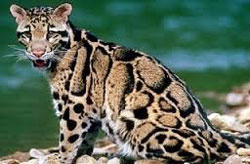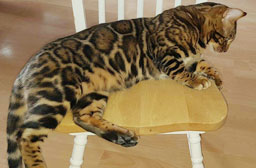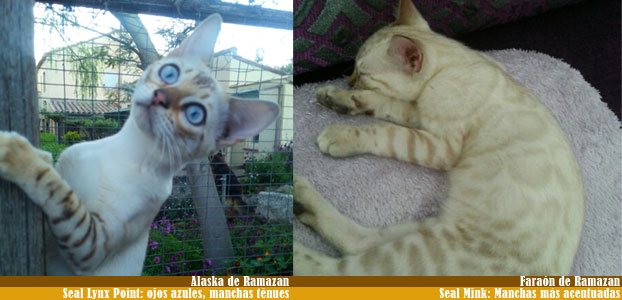Types of the bengal cat
Bengals can be classified by two main aspects: the coat color and the coat design. The combination of the two give the variety of bengals we can see today.
The coat designs that we can observe on a bengal cat are:

a) The Spotted. Dark spots over light coat to give that beautiful contrast. These spots can be dots or rosettes. This way, we can see brown spotteds, snow spotteds or blue spotteds, as the main varieties..
b) The Marble. This design is like dark and light swirls all along the coat. These swirls combine brown, dark chocolate, black and cream (depending on the color coat), create one of the most interesting coating effects. This way, we can find brown marbles, snow marbles, and blue marbles.
c) El sparble. This design type is a mix between the spotted and the marble, swirls and rosettes working out unusual beautiful markings with great spacing in between. You will know when it is a sparble, when you don't know if it is a marble or a spotted.
d) The clouded. This design stems from the spotted, and rosettes are huge with little spacing in between, which reminds us of the pattern of the clouded leopard.

Clouded Leopard

Clouded bengal cat
The coat colors a bengal cat can show are:
1) Brown. The coat is a light brown or cream, and even in some occasions orange. It can have spots, rosettes or swirls (marble effect). These marks must be darker than the coat: combination of dark brown, black, light brown and cream.
2) Snow. There are three main types of snows: Seal Lynx Point, Mink and Sepia. The coat can show spots, rosettes or swirls (marble effect). These markings must be darker than the coat: grey, dark brown, chocolate.
3) Silver. The coat must be totally white to highlight the dark markings which can be spots, rosettes or swirls. They were recognized during the year 2004, some of which were Champions. They must not show any golden tones on their feet, face, tummy and spine.
4) Other colours. We find many other colours like the blue, cinnamon, melanistic, among others. Even though they are not recognized colours by the bengal standards for competition, there are certain cat clubs that allow you to participate in the new colours cattegory. One of the remarkable colours is the blue, there are some catteries that work with this colour, that combines a cream coloured base and blue rosetting with a silver glitter, eyes are usually green. It is an unusual variety but beautiful too.
This way, when we talk about bengals we can be referring to one of the following types:
1. BENGAL BROWN SPOTTED
2. BENGAL SNOW LEOPARD
3. BENGAL MARBLE
1. BENGAL LEOPARD SPOTTED The Leopard Spotted nowadays has stricking rosettes known as donut rosettes with high contrast placed on a light cream base coat with rich chestnut tones. In the picture below, we see various types of rosettes, but they all have the similarity of having a dark outline and a brown tone in the inside. The inner colour of the rosette ranges from rich orange tones, passing through the ochre, to the browns and to the beautiful rich chestnut tone.
Another part that varies is the base coat, which can range from very light colours to warmer tones known as buttercoat, which is highly appreciated. Altogether, all these varieties in tones and colours are equal to the different types of likings of people, and each one just have their favourite combination.

Some years ago the bengal started to show the beginning of the rosette formation that offered different types of variations: a) the paw print rosette, which had a broken dark outline that combined spots and lines with an inner brown tone, contrasted by a light base coat; b) arrow rosette, two tones in the shape of the point of the arrow, one brown tone and on the outside of one side a dark line; c) two tone rosettes, rounded spotting that combined on one side a brown colour and on the other side a darker colour. We have prepared a selection of coats that show these different types of rosettes that was common plenty of years ago.
Nowadays you may still find these, but in serious and committed catteries with the bengal breed they only use studs and queens with the new type of big rounded donut rosettes, combined with other varieties of rosettes on the coat, for instance, the chain-rosetting on the top, etc.

[up]
2. BENGAL SNOW LEOPARD The snow leopard has a white-pearled or cream coat with chocolate or brown markings. Their eyes are blue. Nowadays, we can also find snows with green eyes, with even more dark markings to offer more contrast. They are called “Green-eyed Sepia Snow”. The snow leopard can be spotted and marble.

The only snows that have green eyes are the Snow Sepia, the other two varieties have blue eyes. The most pronounced markings are the ones of the Sepia and the Mink. The Seal Lynx Point is the one with very faint markings, when they are born they are practically white, and their markings take a long time to appear, nearly a whole year. [up]
3. BENGAL MARBLE The marking of the marble has been introduced by the “Classic Tabby Gene”, one of the domestic cats used for the beginning of the bengal breed creation.

The marble markings are created by gracious swirls horizontally aligned, which makes it different from the conventional cat that offers a vertical alignment of the swirls, known as "bullseye" which is an undesired feature in the marble.
The tones in a marble swirls are black, brown, gold, rufus and cream. The marble is important in the breeding program to enhance the quality of the rosettes. In the same way, we can find snow marbles and silver marbles, among other coloures. [arriba]



